MUSSAENDA (Mussaenda erythrophylla): PLANT WITH MIRACULOUS PROPERTIES
Dr. Amar Singh
Former A. Chief Technical officer
I.A.R.I., New Delhi-10012
INTRODUCTION:
Mussaenda has become a very popular ornamental shrub owing to the colorful petiole bracts it puts forth. It is placed in the plant family Rubiaceae. The leaves are 7.5-12.5 cm. long broadly elliptic and hairy, especially along the 8-12 pairs of veins. The golden yellow flowers, in open cymes are rather inconspicuous in comparison to the colorful petiole bracts. The berries are sub globosely or obovoid, smooth and shiny.
Mussaendas, often known as Bangkok Roses, are popular throughout the tropics and subtropics of the world. Over the warmer, wetter months of the year they grow strongly and provide quite a show in gardens. You can spot them at a distance, the shrubs being covered with showy white or pink or red flowers which at times obscure the leaves. While many of the showy hybrid plants dislike cool dry weather, many of the Mussaenda species are a lot hardier and grow in cooler subtropical districts in sheltered spots. Plants are generally in flower from May to November, although many of the species can flower almost all year round in ideal climates.
It is a good houseplant and you can even grow it in a container. Its ‘Queen Sirikit’ cultivar produces pale yellow to white flowers with red centers and pink bracts. The appearance of the plant may vary depending on the specific species and variety of Mussenda. Some species have a more erect, tree-like habit, while others have a more spreading, shrub-like habit. The size and shape of the leaves can also vary, as can the shape and size of the flowers.
In general, Mussenda plants are known for their lush, tropical appearance and their showy, colorful flowers. They can add a touch of whimsy and beauty to any garden and are a great choice for anyone looking to add a tropical touch to their landscape.
The musenda plant is a great choice for any gardener looking to add color to their garden as well as medicinal uses. They are especially well suited for border plantings or use in containers, and they make a great choice for gardens in tropical or subtropical climates. So if you want to turn your garden into a work of art and harness its medicinal properties, then adding some Mussenda plants to the mix can do the trick!
Overview
Scientific name: Mussaenda erythrophylla
Common name: Mussaenda, Paper rose
Plant type: Flower
Sun required: Full Sun to part shade
Flower color: Yellow, red, creamy white with red, white or pink
Blooming time: Seasonal bloomer
Soil: Well-drained organic-rich soil
Soil PH: 6.0- 7.5
Common name
It is popular with many names like Mussaenda (Red, yellow, white, pink), Mussaenda, Red Flag Bush, Tropical Dogwood, Mussaenda Red Single, Bedina, HanuRei, Vellaiyilai, MithaiPhool, Encana (Dwarf Mussaenda), Mussaenda ‘Queen Sirikit’, Mussaenda ‘Capricorn Dream’ etc.
Varieties:
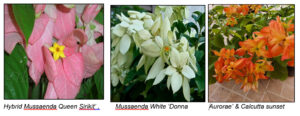
There are many different species and cultivars of Musenda plants available in the market. Here are 10 common varieties॰
This highly decorative Mussaenda flower plant in tropical areas contains more than 200 known subspecies, but only 8 to 10 varieties are more popular for garden as well as medicinal uses. In the last few years, much work has been done in India to make more color and hardening of the plant. ‘Rosa’ or ‘Queen Sirikit’ and White ‘Donna Aurorae’ are the most popular in India. Brilliant ‘Red flag bush’ is also a great hybrid, the orange flower species is called ‘Maemelada’ or ‘Calcutta sunset’. The variants in which there is a single bracts flower, the more surprising.
- 1. Mussenda Frondosa: It is a large, bushy plant with glossy green leaves and clusters of white, pink or yellow flowers. It is native to tropical regions of Africa and Asia and is often used as a hedge plant or ornamental shrub.
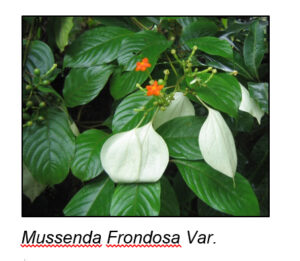
2. Mussenda erythrophylla: It is a small, bushy plant with shiny, dark green leaves and clusters of small, red flowers. It is native to Central and South America and is often used as a groundcover or in containers.
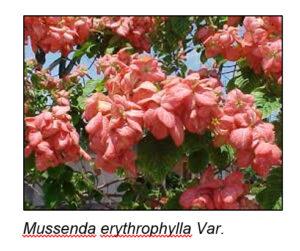
3. Mussenda Phillipica: It is a medium sized shrub with glossy green leaves and clusters of white or pink flowers. It is native to the Philippines and is often used as a hedge plant or ornamental shrub.
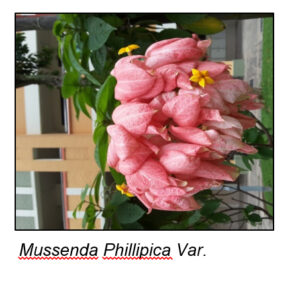
- 4. Mussenda arcuata: This is a small, bushy plant with shiny, dark green leaves and clusters of small, yellow flowers. It is native to Central and South America and is often used as a groundcover or in containers.
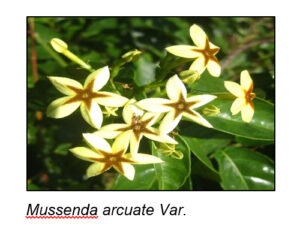
- 5. Mussenda pubescens: It is a large, bushy plant with glossy green leaves and clusters of white, pink or yellow flowers. It is native to tropical regions of Africa and Asia and is often used as a hedge plant or ornamental shrub.
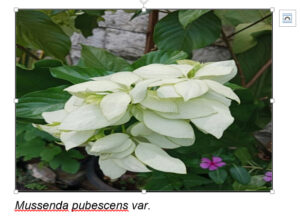
- Mussenda imodi: It is a small, bushy plant with shiny, dark green leaves and clusters of small, white flowers. It is native to the Himalayan region and is often used as a groundcover or in containers.
- Mussaenda Glabrata: This species has medicinal uses, which is used to cure some chronic diseases.
Mussaenda Glabrata Var.
Each of these varieties has its own unique characteristics and is suitable for different garden applications. By choosing the right variety for your garden, you can create a beautiful, tropical oasis that will flourish for years to come.
Climate: Mussenda plants are native to the tropics of the Old World and are best suited to warm, humid climates. If you live in a cold climate, you may want to choose a musenda variety that is more cold-tolerant or grow your musenda plant in a container that can be brought indoors during cold weather.
Sunlight: Mussenda plants prefer partial to full sun, so choose a spot in your garden that gets ample sunlight. If you are growing your Mussenda plant in a container, be sure to choose a pot that is large enough to accommodate the plant’s root system and place the container in a sunny location
Soil and location
Musenda plants prefer well-draining soil, so make sure you choose a spot in your garden with well-draining soil or use a potting mix designed for tropical plants Do it.
It is grown in a completely fertile, dry and organic-rich, medium moisture soil. Winter hardy USDA zones 9-11 its grows well. They prefer full sun, so place it where there are less than 6 hours of sunshine. To get its shiny color, there is direct sunshine of morning and evening and shade in the hottest time. These bushes give you happiness in the hot months of the year and for a long time in the future.
Propagation
Mussaenda propagation can be done with soft or semi-hardwood cutting. Another way of propagating is air layering and for this, the spring and rainy season are most suitable. Seeds are rarely used.
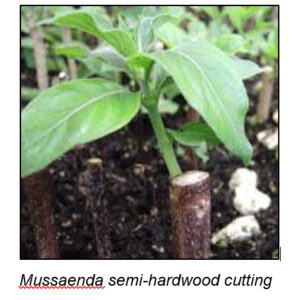
Fertilizing
Plants prefer organic-rich and fertile soil which is heavily fed, these plants are regularly fertilized. Due to the lack of nutrients, the plant can be damaged. Nutrients are easily separated from the soil in high rainfall areas. Using organic fertilizers is more beneficial. Benefit from regular organic, leafy fertilizer applications. Apply liquid fertilizer early in the morning or in the evening. Apply fertilizer during the beginning of the plant’s active growth period, which is in the spring for summer plants and the fall for winter plants. Select a fertilizer with a higher nitrogen and phosphorus content if you want your plants to bloom or produce fruit.
If you’re applying fertilizer that dissolves in water, do these things:
- Follow the mixing instructions on the packaging for the best results.
- Wet the leaves and saturate the ground with the mixture.
- Repeat.
When applying fertilizer in granule form:
- Put a thin layer of general-purpose fertilizer under your plants from the base to the furthest branches or leaves.
- Water slowly and thoroughly.
Watering
Make sure to keep the bush water once or twice per week, it keeps moisture in the soil which is necessary for the plant, but do not let the mud. Water the plants during dry periods, the plants suffer from dryness and can be absorbed and die.
Size: Mussenda plants can grow up to 15 feet tall, so be sure to choose a variety that is the right size for your garden. If you are growing your musenda plant in a container, be sure to choose a pot that is large enough to accommodate the plant’s root system.
By considering these factors, you can choose the right musenda plant for your home and create a beautiful, tropical garden that will thrive for years to come.
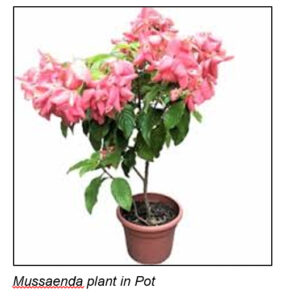
Pruning
Mussaenda bush is a stroller and benefits from annual pruning are beneficial. Generally, it should not be removed more than 1/3 of the development. If more renewal is required, then it is better to have long-term sorting, gradually reducing its size as required. Some species and varieties become climbers, they can also be trained with fences. Removal of dead flowers and bracts is also advantageous in the flowering season.
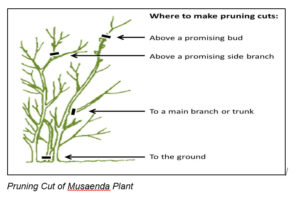
Disease and Insect;
Musenda plants are relatively resistant to pests and diseases, making them a low-stress option for gardeners. If you notice a pest or disease on your musenda plant, there are natural pest control methods that can be used to address the problem.
These plants do not have any serious pest or disease problem. Especially if their nutrition and climate requirements are met. These can usually be subject to mili bugs, and in turn, it can cause the sooty mold growing on the honey. Hot, dry conditions encourage these insects. Spider kites and whiteflies can also be seen on indoor plants.
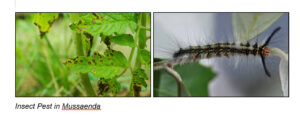
Uses Musseanda flower
Musseandas bushes are usually planted behind the boundaries of the garden; they are tall shrubs, due to which their feet are often bare, to cover it, you can plant a ground cover plant or lower bush. For this, you select those plants that the selection of those plants is not firm and can compete with them.
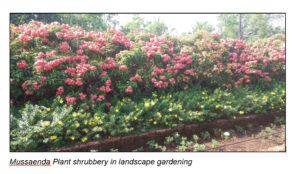
Mussaenda Plant care tips
- Mussaenda requires very hot temperatures to spread, and hence its propagation usually ranges from mid-January to autumn.
- Keeping your plant from sun to partial shadow, keeping in mind a little bit of security with strong winds.
- Hot months they grow very rapidly, and its branches remain slightly soft and there may be the possibility of loss in exposed sites.
- Spread the 2 inches deep bark mulch around the bush. Keep it 3 inches away from the bush stem.
- Water the bush once or twice per week, thereby keeping moisture.
- These bushes are not particularly fussy about soil or condition, but in the spring when the leaves begin to grow, it should eat well, at this time it also requires good marching.
- Cut them back late in the winter is quite difficult. Pruning promotes the development of the plant, which helps in better Mussaenda flower production.
MEDICINAL USE:
Some important medicinal properties of Mussaenda
- Leprosy and jaundice.
- Promotes the flow of urine.
- Asthma, intermittent fevers and oedema.
- Ulcers.
HOW TO USE:
- The decoction of the root is used to cure leprosy.
- The decoction of the leaves mixed with milk is given to cure jaundice.
- The decoction of the flowers is given to promote the flow of urine.
- The same decoction of the flower is given to treat asthma, intermittent fevers and oedema
- The paste of the flowers and leaves may be applied over ulcers.
PARTS USED:
The roots, leaves and flowers.
- Toxicity
- Your Mussaenda Frondosa Plant is considered to be mildly toxic to pets and humans as well.
Conclusion:
If you’re looking for a classic, elegant look, then white mussenda plants may be your best bet. White flowers can add a clean, fresh look to your garden and can be combined with many other colors.
If you want to add a touch of cheer and sunshine to your garden, yellow musenda plants may be the way to go. Yellow flowers can bring a bright, cheerful vibe to your garden and can be especially attractive when paired with darker foliage.
Pink mussenda plants can add a romantic, feminine touch to your garden, while red mussenda plants can add a bold, vibrant look.
Ultimately, the best color for you will depend on your personal style and the overall look you want to create in your garden. Consider your existing garden color scheme and choose a musenda plant that will complement your existing plants and help bring your garden vision to life.
Have a think about where one of these plants might do well in the garden and earmark that spot …… a warm sheltered northern location where it will get sun for much of the day. Better still, how about a mass planting of your favourite cultivar or species? There is nothing like making a strong statement in the garden! These shrubs are sure to give you pleasure over the warmer months of the year and for many years if not decades into the future.
Mussaenda is a genius genus of beautiful flowers with attractive colors.

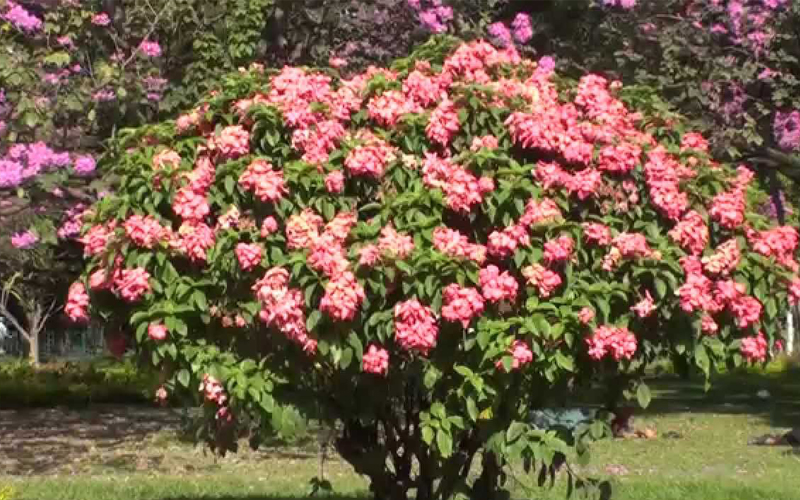
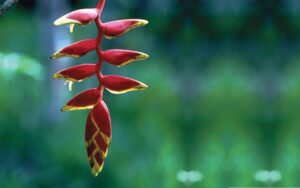
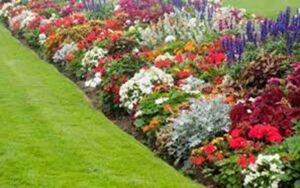
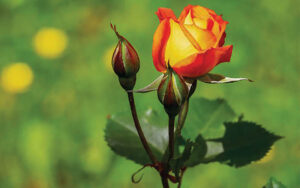

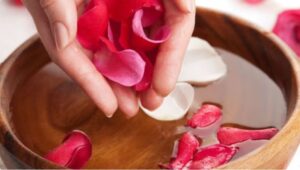

Hi there, every time i used to check web site posts here
in the early hours in the dawn, as i like to learn more and more.